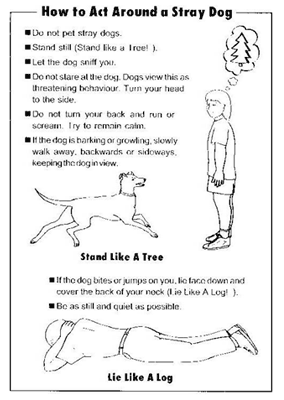 |
|
NEW In This Issue!
|

Issue #0008 - Published by L. Neilson

|
|
This newsletter is dedicated to parents and their children. If we can prevent just one dog bite to a child by educating children and their parents, we have accomplished what we have set out to do.

The friendship of a dog can be wonderful for children's emotional and physical health. But children-especially those nine and under- are most at risk for dog bite injury.
According to the Canadian Hospitals Injury and Prevention Program, about 500 children are hospitalized annually for dog bites. The Humane Society of the United States has found that 4-5% of children's visits to emergency rooms are due to dog bites. As well as disease and disfigurement, dog bites can cause long term emotional trauma.
Most people recognize that stray dogs can pose a danger, yet most dog bites are by dogs known to the victim - the family dog or dogs in the neighborhood. Thankfully, dog bites are mostly preventable by encouraging responsible dog guardianship and by teaching children safe behavior around dogs.
"Parents should be encouraged to teach young children to treat all dogs with the greatest respect for their own personal safety"
|
|

- Ask permission before petting someone else's dog
- Leave mother animals and their young alone
- Do not try to pet dogs that are tied up, sleeping, eating, behind fences or in vehicles
- Do not chase or tease dogs, or pull their ears or tails
- Do not grab their food, bones or toys
- Do not try to stop a fight. Call an adult for help
- Always act kindly and gently. Animals have feelings too
- Remember that cats can scratch and bite unexpectantly
- Leave wild animals alone
- Report the details of injured, stray and threatening animals to an adult who will call the SPCA/humane society or animal control authorities

The vast majority of dogs are safe, reliable companions. But even a friendly dog may bite if threatened, angry, afraid, or hurt. Some dogs can be described as dangerous - bred or trained to be aggressive, with predatory instincts that may cause them to chase and attack a fleeing child.

Just as humans do, dogs protect things they care about, whether food, their puppies or favorite toys. They also protect spaces - their own and their guardians'. Eating and sleeping areas, yards, porches, and parked cars are all commonly defended by dogs. A child reaching through a fence or arriving unannounced at the door can turn a neighbor's warm, loyal pet into a growling, loyal protector. Dogs provide us with protection. We must ensure children understand this and are aware of situations that may frighten or anger a dog.
|

Did You Know?
Experts agree that the solution to avoiding dog bites to children is through education.
More than 1/2 of all children will be bitten by a dog by the time they are 12 years of age.
Every 40 seconds someone is presented to an emergency room in the US for dog bite related injuries. About 60% of the victims are children.
That 61% of dog bites occur in the dogs own home or the home of the victim.
That 77% of dog bite victims are members of, or close friends with the dog owner.
Most dog bites occur in the spring of the year.

|


- Wash the wound with soap and water
- See a doctor right away
- Remember everything you can about the dog - and report the bite to your local SPCA, animal control or health department
|
Cornering, crowding, or standing over a dog, particularly a small one may make it feel defensive. Children should stand back and never put their faces close to a dog's mouth. The face is the most common site of serious dog bites.
Stray dogs may be dangerous. Any dog that is loose may be lost, frightened or injured - and more likely to bite.
Sick or injured dogs may be afraid or irritable and should be avoided by children.
Elderly dogs may have impaired vision or hearing, or be more sensitive to touch which can cause them to be more easily startled.
Dogs living with or around children need to be able to tolerate a degree of rough treatment without resorting to biting. Choose your dog carefully and discourage even play biting by puppies, to avoid problems later.
Most children's dog bite injuries occur during play with a dog they know. A dog that is nervous or excited can bite by mistake. Children should be taught not to play fight, tease, yell at, or chase dogs or other animals.
Dogs can feel left out, especially when a new baby or pet joins the household. Give a dog extra love and attention at these times.

Under the law, guardians can be held liable for their dogs' actions-including bites. You can reduce the likelihood of your dog biting someone by observing these points.

- Socialize and train your dog. Most dogs can be trained/socialized not to be aggressive
- Do not let your dog run loose. Avoid having young children walk dogs they cannot control
- When you meet children while out for a walk, ensure they approach your dog properly
- Teach your children to observe the simple rules of safe behavior around dogs. In particular, teasing, chasing, and yelling should be discouraged. Your dog may tolerate it, but another will not
- When you meet children while out for a walk, ensure they approach your dog properly
- Teach your children to observe the simple rules of safe behavior around dogs. In particular, teasing, chasing, and yelling should be discouraged. Your dog may tolerate it, but another will not
- Choose your dog carefully. Pups should be evaluated in light of the parent dog's behavior. Select dogs that have been bred to be non-aggressive family dogs
- Do not leave babies or young children alone with a dog
- Children should be taught to NEVER HUG A DOG. Many dogs tolerate such behavior but others may not
- Children should be taught to ALWAYS ASK PERMISSION to pet a dog
- Children should always pet a dog in the chest area. NEVER PET A DOG ON THE TOP OF THE HEAD.

The information contained in this newsletter is intended for the education of children of elementary school age. The writer has purchased this, and additional information from the BCSPCA, and is permitted to share this and other information for educational purpose. The writer has presented the complete course to several schools in Calgary. Please note this newsletter contains only part of the Bite Free program. For complete course details and availability, please contact Konfident Kanines Inc. at larry@konfidentkanines.com
|

|
 |
 |
|








